Previously in order to run airconditioning, washing machine or coffee machine we had to run the generator, which was making noise & smell and is consuming gasoline. In order to get rid of this we needed to convert to Lithium, inverters, solar, new alternators and a whole bunch of cables and other drama…
After a lot of research we finally agreed with a Dutch company called Top-systems aka stroomwinkel.nl to help us with the design and delivery of goods in Croatia. Installation would be done by ourselves based on provided scheme’s.
It all started with deciding where to put all this stuff in terms of space and weight distributions well as a complete breakdown of power usage and peak usage. After all information was gathered we could finally start the design process. As some of you might now lithium batteries are known to be quite hazardous in terms of fire. Therefore temperature control was gonna be a main concern. Also these guys don’t like to much shocking movement (hmmm we are a sailboat bouncing on waves).
We concluded that we were not gonna make use of 5 heads (bathrooms) in our boat with a family of 4 with sporadic guests on board, so we decided to offer one for this purpose as well as some more features in favor of loosing this head. These features would be an extra fridge freezer and closet for Daniella to store some more clothes. I took the whole head apart, removing walls, sink, toilet, shower etc. Then created some reinforced flooring using hardened multiplex (betonplex) to facilitate the INOX boxes containing the lithium batteries. On top of that I created a next level to facilitate the closet, technical room and the fridge/freezer. Ofcourse I created openings for all cables and rounded the edges using the router.
Also we received quite an interesting scheme for the electrical environment which will be used to install all required cabling and appliances.
Above schemes were created after a lot of sessions to discuss possible strategies, most important decisions I will outline here together with my motivation:
We needed 230v as well as 110v when plugging into shore across Atlantic: therefore we implemented two isolation transformers in starboard engine compartment with both their own dedicated shore connection at the starboard sugarscoop next to the factory ones for Aircon and AC input. Reason for adding instead of reusing current ones is from redundancy perspective. In case the new environment is not working I can always plugin to shore to have the factory 12v system running as it was before. One thing to keep in mind is that we installed a 7000w 230v transformer generating 7000w on secondary side and one 7000w 110v transformer generating 3600w on secondary side. This way all the rest upstream in the system can be 230v components, although half the power in case of 110v. In reality these shore connections will be barely used and will have a fallback function only in the configured “sustain” mode on the Victron Quattro’s.
-We wanted to keep the whole boat as is in terms of 12V systems for winches and navigational stuff: Never change a running system was the idea here, didn’t want to invest in new winches, nmea devices and fridges/freezers as well as lights. This way we could maintain the whole 12v system as is and make it think there is a shore connection forever. In that concern it is important to configure the 230V chargers very well to keep the batteries in good shape. Also here again redundancy, in case of failure in the new 24v system, everything can stay operational. And as a last resort a spare DC-DC converter can keep systems running the other way around when 12v system breaks down using the new 24v bank.
-We wanted to be able to run AC almost 24/7 (at least all night) in 2 cabins: Due to the fact that we will mostly be traveling close to the equator and in tropical climate we wanted at least to have a good sleep at night, especially the little kids that go to bed early when there is still a lot of heat in the air. I know there’s a lot of different opinions about this one, but at least we have the option if needed.
-We wanted to say goodbye to all gas onboard, which meant electrical oven and induction cooking: In my opinion gas is the most dangerous good on board of a ship and therefore I wanted to say goodby completely. A common heard reason to keep it is also redundancy in case of long crossings, one can always prepare food. I will take enough charcoal for that purpose and use the BBQ if neccesary. We installed a 4in1 oven which can do convection, steam, grill and microwave and performed really good. Next to that an IKEA induction hob with integrated vent and carbon filter.
-We wanted to be able make use of coffee machine, washing machine, dive compressor and water maker without generator: For this reason we installed 2 Quattro’s working as Master/Slave capable of doing 10000W AC in ideal conditions, but when getting warmer will maybe drop to 7000W worst case, which is still enough to run two big consumers at the same time. Also we configured the battery bank to be able to serve these Quattro’s over the MG LV Master BMS. Delivery is capped to 600A on 24V from MG Battery bank to LV Master which in theory could almost serve another Quattro of the same size.
-We wanted the default 12v bank and engine batteries to be charged using factory Cristec chargers already installed in starboard engine compartment: We connected the AC1 Out from Quattro’s in parallel with the factory shore connections so this acts as the power feed for the 12v system via the Cristec chargers, same applies to the engine batteries.
-We wanted to be able to charge the new 24v bank using shore power: This is done over the dedicated isolation transformers.
-We wanted to install second autopilot on 24v in case of issues in 12v environment: We installed a second autopilot identical to factory one except for voltage ad hooked up to 24v feed, in case of failure I only need to switch nmea connector.
-We wanted to install 18 solar panels of 430W each in 4 strings 2x 3s2p (solar arch) and 2x 2s2p (Bimini): In order to not have to much loss due to shades of the sails we configured 4 solar arrays. Bimini is splitted into left and right section and arch same split. Panels are bifacial and have some advantage due to reflection on the white hull/deck as well as by the tender. Common mistake is that people think that water is also reflecting, but in reality it isn’t because it absorbs the light.
-We wanted the engines to charge 12v as well as 24v bank separately using double alternators on each engine: We installed Yanmar second alternator kits on both engines to facilitate 2 extra 24v/150A Bosch alternators. These will be controlled each by their own wakespeed regulator and measured by a Victron shunt in order to display their delivery on the Cerbo screen.
-We wanted to incorporate the generator into the Victron Cerbo system in order to schedule planned starts/checks and charging: by using two time relays I was able to hookup the relay output on the Cerbo to the control panel of the Cummins Onan. The relay emulates a 3sec press on the start of the generator and same for powering off. Later I incorporated these relays to the Nmea bus in order to stop/start from my home automation software, and later also over google assistant controlled by my voice. I will write a separate article to explain how to switch items on the nmea bus using your voice.
-We needed to make sure that temperature was in control in this technical room: I created a pipe with two vents, one is always running in silent mode and is keeping up in normal operation, second is controlled via relay output 2 on the Cerbo based on temperature sensor and is an engine compartment fan. Both outputs jin to exit through a hatch where there is a ventilation cap. Although it should be watertight I decided to create an exit for water through what used to be overflow for black water tank (see picture).
-We wanted integration with our MFD’s: Nmea was connected to Ve.Can in order to get values from and to nmea. Victron now runs a nicely build HTML5 app on their cobra which can run on your B&G MFD.
-We wanted the batteries to be placed inside INOX boxes: so in case of fire/heating I’m able to distinguish using dedicated lithium gel distinguisher and endless seawater using deck wash pump running on 12v system (that will keep running without need for 24v bank) and water will overflow to bilge and will be pumped out. Tested the pumping of hot water through Rule bilge pump and no problems…
After two weeks of daily pushing the limits all devices and cables were installed a fully operational, so we could switch the shore power connection to the new environment. Now it is time to start working on the cabling from this technical room towards engine compartments for the alternators, to the Bimini for the solar panels and to the stern for the solar panels.
After all cabling has been done it was time to start working on Inox construction to facilitate the panels. we hired someone to do it and must say I’m very happy with the result. I was afraid it was gonna be super ugly, but it turned out acceptable ugly… To date my experience was in worst case scenario’s when sun was at lowest angle and cloudy days, but peaks of 3kW were reached which made me really happy.
Costs:
2x Victron Quattro 24/5000 230v
1x Victron Isolation transformer 7000w 230v
1x Victron Isolation transformer 3600w 110v
2x Wakespeed WS500 + harness cable
1x Victron Cerbo GX
1x Victron Cerbo GX touch 70
1x MG Master LV 24-48/400A
2x MG Distributor
8x MG LFP Accu 25,6v 230Ah 5,8 kWh
4x Victron Smartsolar MPPT 150/70
Cabling in all sizes (a lot!)
18x Denim solar 430Wp bi-facial
3x Alternator 24v/150A
48.000 Euro excl. VAT


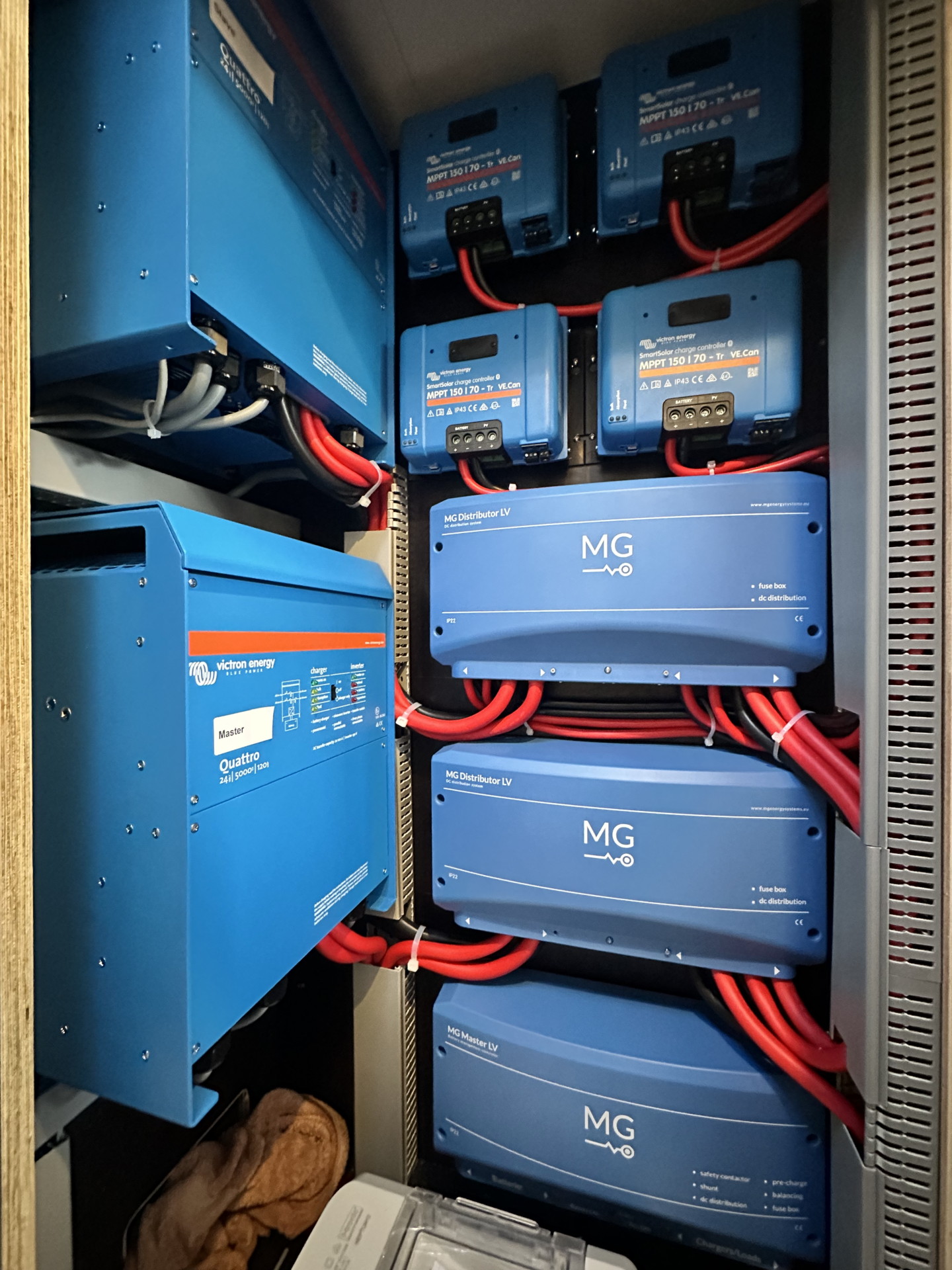




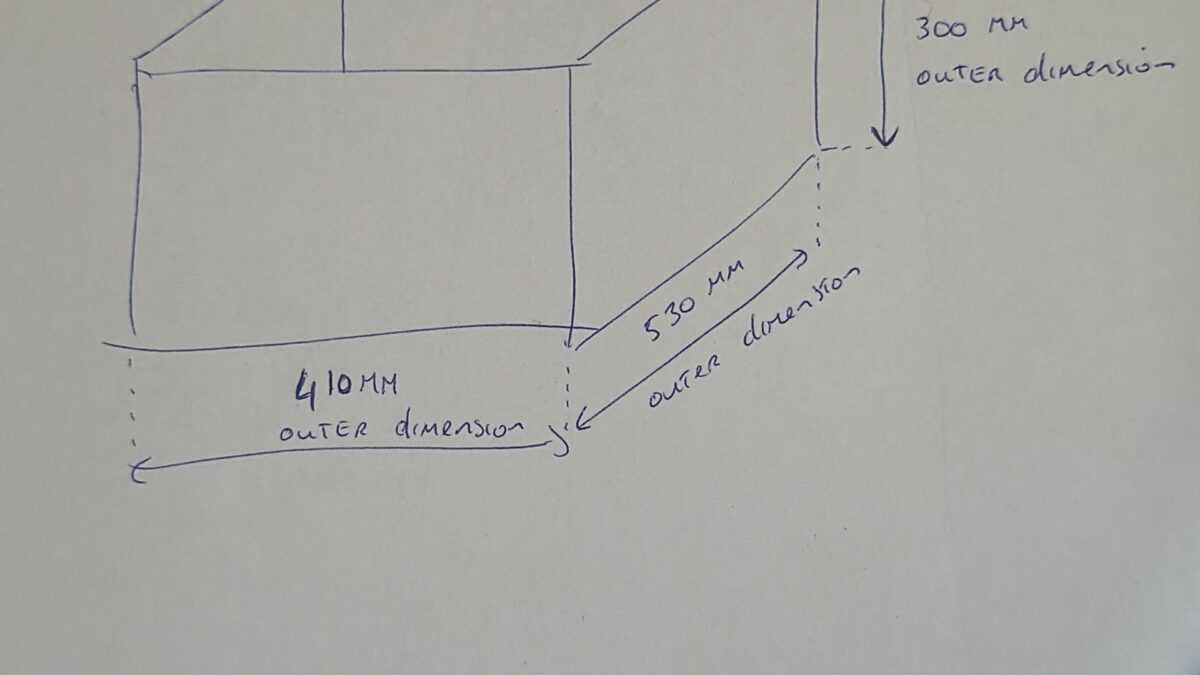






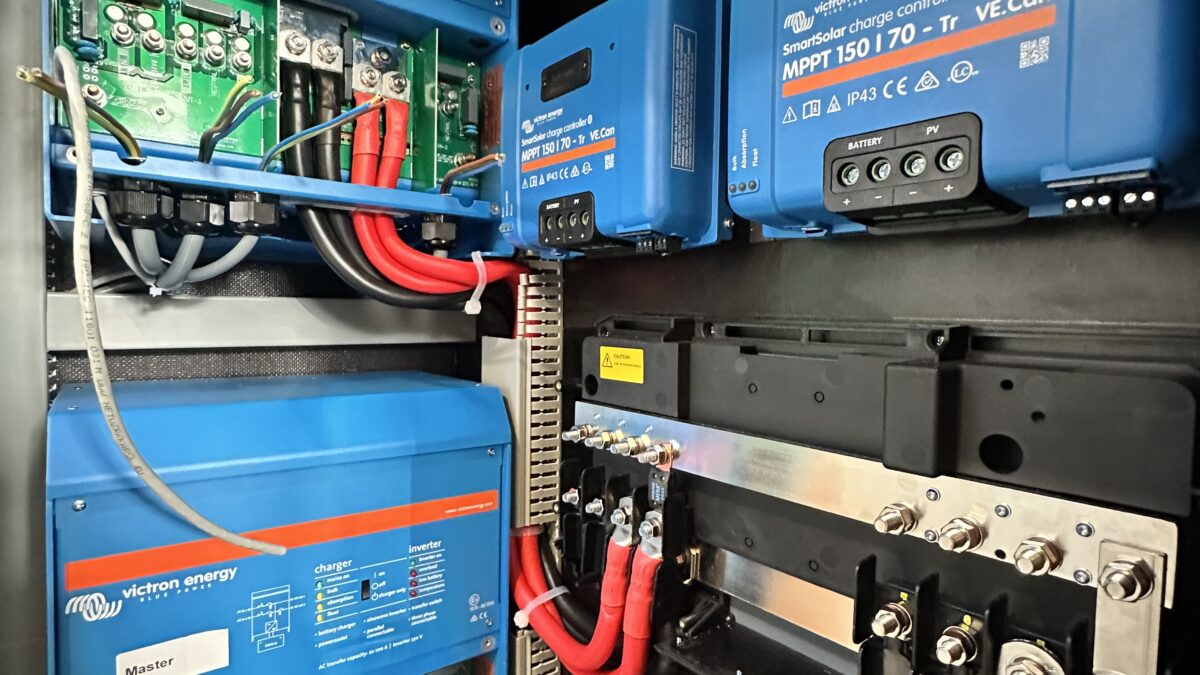





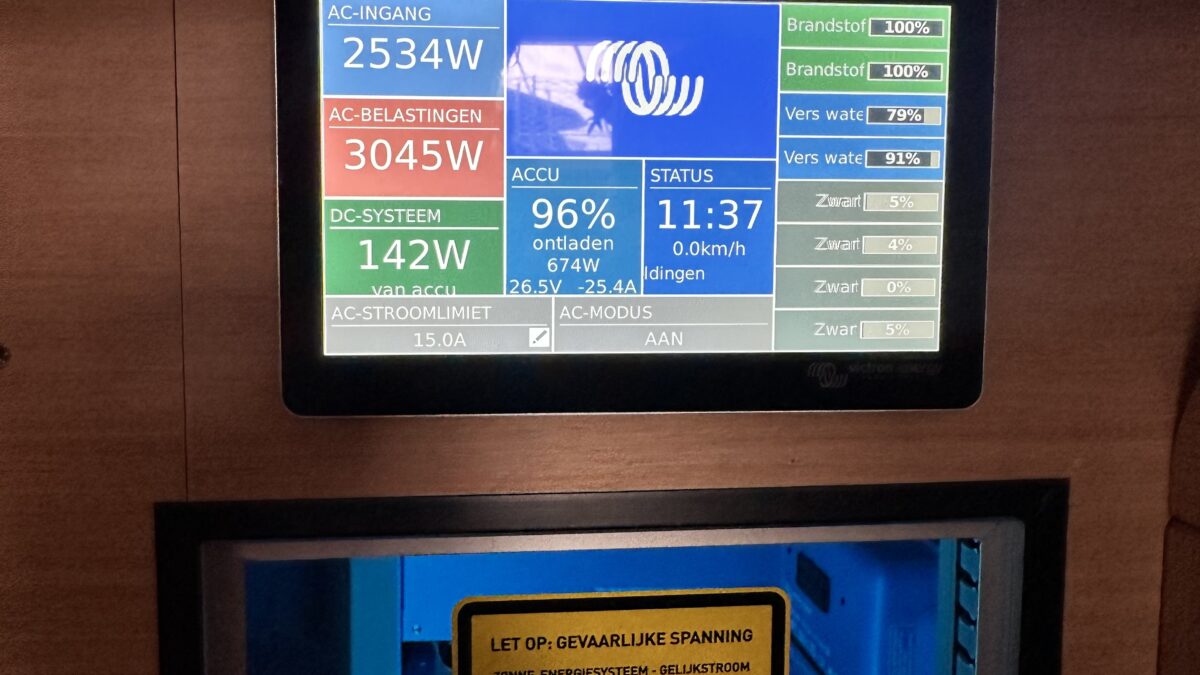


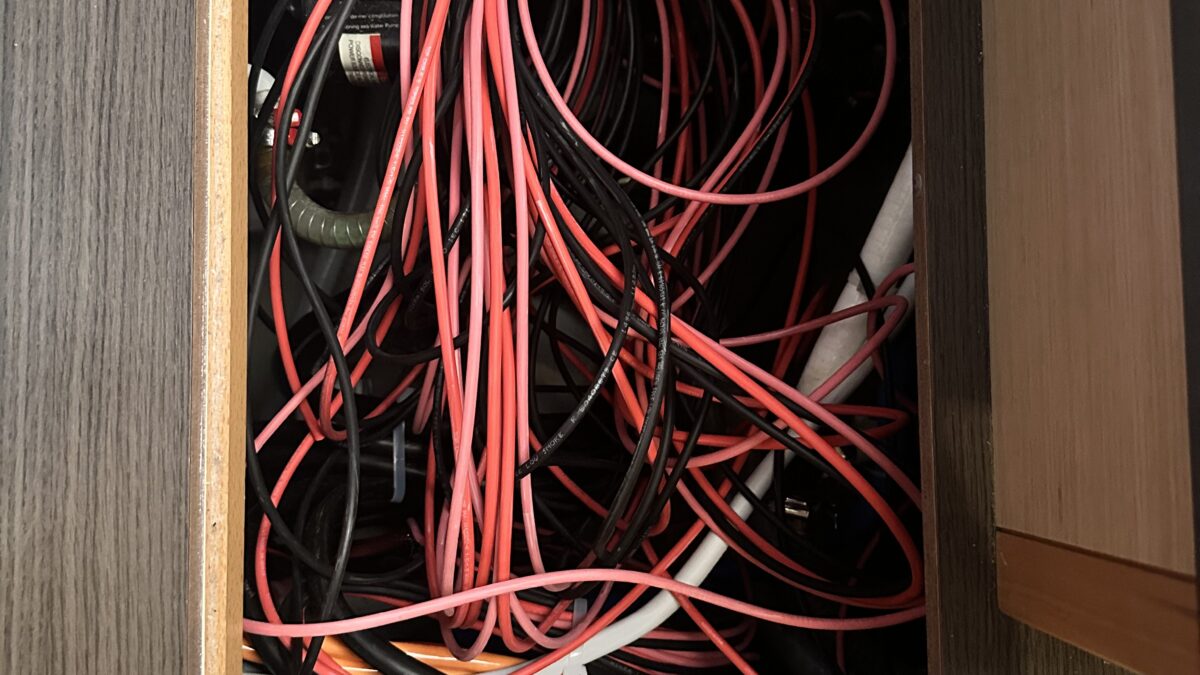



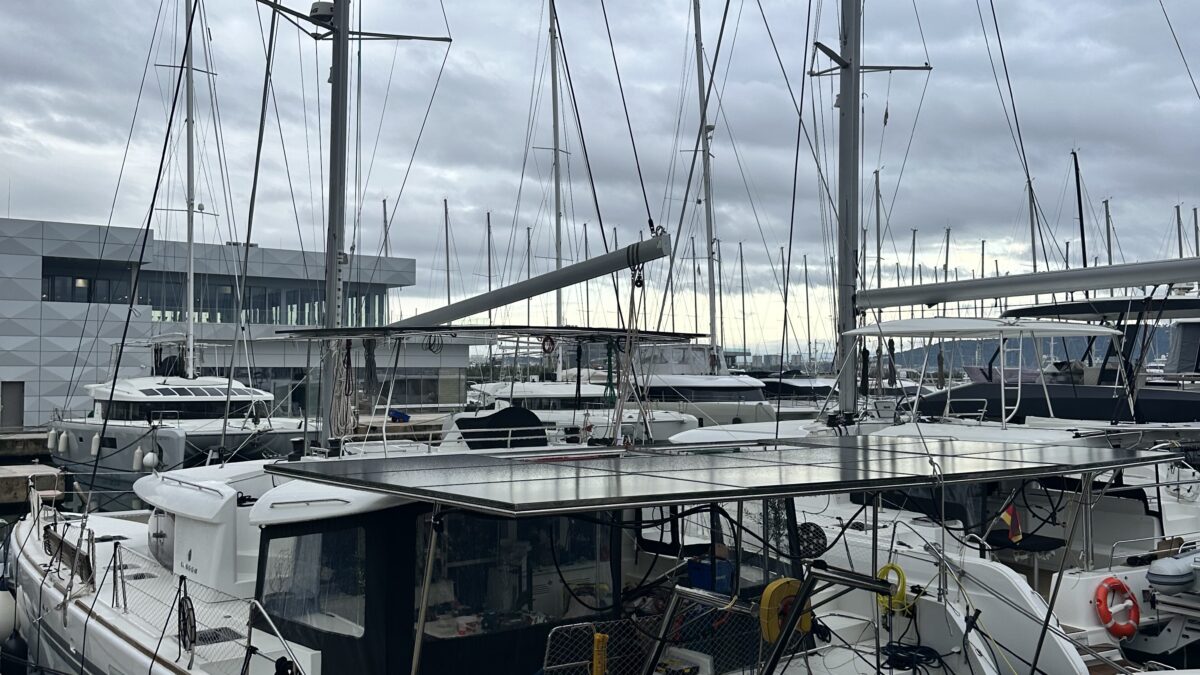



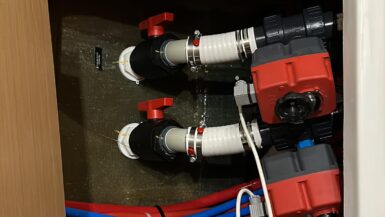
Thanks for this detailed post. What do you estimate the additional weight of the instal to be ?
Hi Fluenta family,
The total weight comes to 1100kg, that’s batteries, panels, inox frame and inverters/mppt’s. I can tell you it’s so nice to have power without thinking of consumption! We run AC all night, Watermaker every 3 days to make 700L, washing machine, cooking etc. And generator has almost been silent since. I only run it every few weeks to keep it alive.
Feel free to contact me if you have any more questions! Always willing to help/think with you!
With kind regards,
Kay